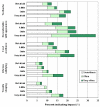The vicious cycle of dental fear: exploring the interplay between oral health, service utilization and dental fear
- PMID: 17222356
- PMCID: PMC1784087
- DOI: 10.1186/1472-6831-7-1
The vicious cycle of dental fear: exploring the interplay between oral health, service utilization and dental fear
Abstract
Background: Based on the hypothesis that a vicious cycle of dental fear exists, whereby the consequences of fear tend to maintain that fear, the relationship between dental fear, self-reported oral health status and the use of dental services was explored.
Methods: The study used a telephone interview survey with interviews predominantly conducted in 2002. A random sample of 6,112 Australian residents aged 16 years and over was selected from 13 strata across all States and Territories. Data were weighted across strata and by age and sex to obtain unbiased population estimates.
Results: People with higher dental fear visited the dentist less often and indicated a longer expected time before visiting a dentist in the future. Higher dental fear was associated with greater perceived need for dental treatment, increased social impact of oral ill-health and worse self-rated oral health. Visiting patterns associated with higher dental fear were more likely to be symptom driven with dental visits more likely to be for a problem or for the relief of pain. All the relationships assumed by a vicious cycle of dental fear were significant. In all, 29.2% of people who were very afraid of going to the dentist had delayed dental visiting, poor oral health and symptom-driven treatment seeking compared to 11.6% of people with no dental fear.
Conclusion: Results are consistent with a hypothesised vicious cycle of dental fear whereby people with high dental fear are more likely to delay treatment, leading to more extensive dental problems and symptomatic visiting patterns which feed back into the maintenance or exacerbation of existing dental fear.
Figures





References
-
- Smith TA, Heaton LJ. Fear of dental care: are we making any progress? J Am Dent Assoc. 2003;134:1101–1108. - PubMed
-
- Armfield JM, Spencer AJ, Stewart JF. Dental fear in Australia: Who's afraid of the dentist? Aust Dent J. 2006;51:78–85. - PubMed
-
- Thomson WM, Stewart JF, Carter KD, Spencer AJ. Dental anxiety among Australians. Int Dent J. 1996;46:320–324. - PubMed
LinkOut - more resources
Full Text Sources

